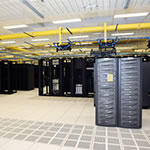Data centers are vital infrastructure in our information-dependent society, but they’re also enormous power users. Companies such as Cosentry, which provides data center services throughout the Midwest, are investing in greener facilities.
Cosentry’s Omaha-Midlands facility, located near Omaha, Nebraska, is the first LEED-certified data center in Nebraska and one of only 21 in the United States. A data center such as Cosentry’s 80,000-square-foot Omaha-Midlands facility draws more power than any other type of building. By way of comparison, a standard home draws less than 5,000 watts of energy; a data center can easily draw 3 million.
The facility is also designed to hold 800 to 1,000 cabinets of IT equipment, which includes the servers and other cloud-computing devices that organizations around the world rely on to gain efficiency, increase security, and reduce costs. Ten years ago, the industry averaged an energy draw of 700 to 1,000 watts per cabinet. Today, that number is closer to 3,000 watts per cabinet, and the Omaha-Midlands facility’s many cabinets draw as many as 20,000 watts of energy.
Cooling is key. The Omaha facility pairs Carrier chillers with exterior cooling towers equipped with plate-and-frame heat exchangers. “When the outside air temperature is low enough, water-side economizers cool the building without operating a chiller, savings 500,000 kilowatt-hours of energy a year,” says facility manager Scott Capps.

Cosentry’s Omaha-Midlands facility is LEED Gold certified.
Most chillers reduce water contaminants—which can impact heat transfer—by chemically treating water, but Cosentry uses a Water Conservation Technology International water-softening program. “We’re not adding chemicals to the environment, and we’re saving 30 percent on our water costs—some 500,000 gallons a year,” says Jason Black, Cosentry’s vice president of data center services.
The building’s mechanicals themselves are also efficient. When running at full loads, Emerson’s Liebert-brand UPS, or uninterruptible power supply, is 97 percent energy efficient, meaning it passes 97 percent of the incoming utility power to the load. Backup power is provided by MTU diesel generators with low emissions and low sound continuation.
The Omaha-Midlands project got off the ground when a client wanted to consolidate multiple data centers in one Omaha location. Cosentry chose to have the building LEED certified because more and more companies, especially those from Europe, are demanding it. The LEED Building Design & Construction rating system was an option, but Cosentry wanted a label that proved performance. “We obtained LEED Gold certification under the Existing Building: Operations and Maintenance (EBOM) rating system,” Capps says, “which proves that our building not only started out efficient, but has been efficient for more than 18 months.”
The effectiveness of power usage in data centers is measured by an efficiency grade called power usage effectiveness (PUE), which is calculated by dividing the building’s total energy load by its IT energy load. The industry annual average is 2.2, Black says, and anything less than that is positive. The Omaha-Midlands facility’s efficiency grade is 1.6, putting it in the top 8 to 10 percent of data centers worldwide.

